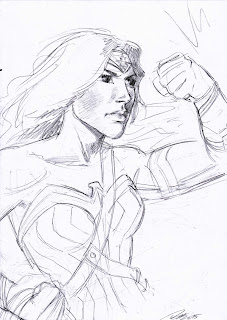STEP 1
-BASIC FORM-
The first step is to block in the basic shapes that - from a distance - give the impression of an environment painted with values. I'd just finished watching a Harry Potter film and was inspired by the Daigon Alley scene. No detail is needed at this point, just broad suggestive strokes. Some variations in form were necessary until I found a composition that works.
STEP 2
-COMMIT-
Once I'm happy with the composition, I commit myself to an idea and start to flesh out aspects of the foreground and values, but remain aware that changes can always be made as I go along.
This also helps to crystallize the concept in my mind.
STEP 3
-FLESHING OUT-
With a better understanding of the image as it develops, I start to put some details in, such as defining textures for the buildings, whilst constantly being aware of the values and lighting present.
STEP 4
-POPULATE-
No environment painting is complete without a population to inhabit it, you can put as much or as little emphasis as you like into sketching figures but it is important in making your environment feel lived in and believable, and also adds scale comparisons. This works especially well for large sprawling environments.
STEP 5
-POLISH-
Now that I've solidified the concept of an 'old village', it wasn't complete without something to draw the eye into the distance. I sort of had an idea about this at the beginning but hadn't decided what I was going to do at that point. In the end I chose to go with a much larger concept than I'd originally planned, by expanding the village with lots of rooftops and a cloudy sky.
If you got to the end of this post, (or skimmed through it) I'd like to thank you for reading through my creative process, and I welcome any comments or suggestions for future posts.
To view my personal portfolio, visit:
http://www.smartcreativz.com/
Till next time...keep sketching:) Pat































